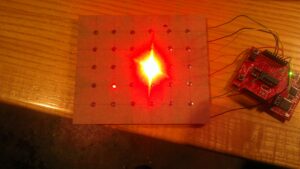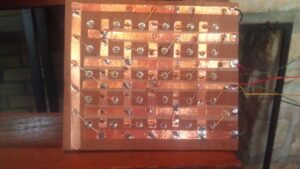Huzzah!
I know I certainly had a really fun time last night with everyone.
I know I certainly had a really fun time last night with everyone.

Tonight is the first lab session for our series on learning how to program in study of games with JavaScript. Can’t wait to see everyone here in just a few hours!
Additionally, for anyone who couldn’t make the weeknight-at-7pm time slot, I’ve cleared some time this Sunday to do a repeat/additional session–Sunday, August 12th, at 3pm. You can get tickets here: https://www.wepay.com/events/intro-to-game-programming-with-javascript-weekend-edition
Or hell, just click the button:
Sunday, August 12th, 3pm – 5pm, @ Hive76 Register
The first game is, as promised, Pong. You can see the game in action here: http://wedusc.com/games/pong.html
And you can read the source code online in my GitHub repository here: https://github.com/capnmidnight/JS_Game_Programming_Class/blob/master/pong.html
I’ll have printouts for everyone when you get here. If this is your first time trying to read code, try not to cross your eyes too much. We’ll cover how to read code along the way.
Though this game is pretty simple, it has a few interesting features…

A few questions came up in the last post, so here are some answers summarized for anyone who doesn’t read blog-post comments.
 This 5×6 LED tile is a key component in a secret project that I’m developing (in secret) with some other folks (whose names shall remain a secret).
This 5×6 LED tile is a key component in a secret project that I’m developing (in secret) with some other folks (whose names shall remain a secret).
Why be so public about something so secret? Because this tile uses a layout technique that lets you build charlie-plexed LED arrays quickly and cheaply — and that’s something worth sharing.

You need to flip the tile over in order to see what’s special about it. Here’s a quick list of features that make the assembly what it is:
The resulting circuit allows you to individually address any of the thirty LEDs in this 5×6 matrix using only six lines from a micro-controller. Continue reading “Hand-crafted Charlie-Plexed Tile”
Modified MendelMax #2 was born today. Isn’t she purty. This bot is gonna live at Hive76 for the forseeable future.
Thanks to all at Hive76 for help and support during this build, especially to Rich and Andy for hanging tough in the trenches, Chris and Brendan for troubleshooting and tools, and Morfin for extra supply bits.
We’ve got big plans for this bot. Stay tuned. And here’s a video of the first print!
I have been using OpenSCAD to design the objects I 3D print these days. Take for example my printed towel rack pictured here.

The design is parametric, which means that each aspect of the design is customizable. I had a specific diameter rod to use, so I entered that value into the code. If you would like to make your own towel rod, you could download the code that I wrote, and change the diameter of whatever rod you find to use. In this way the design can meet everyone’s needs with very little effort. This also means that sharing the design is much more valuable for others.
In this class you will learn the basics of OpenSCAD and reproduce a simple design from scratch. Some prior knowledge is required; basically that when you code, you need to spell things right and close brackets. OpenSCAD is fully cross platform and easy to install. Feel free to bring an idea for a 3D printed object, but make it practical. OpenSCAD does not excel at organic pretty things. Continue reading “OpenSCAD class August 4th: Learn parametric CAD for 3D printing”
Just wanted to let everyone know that we’re about two weeks away from the class. You can still register for tickets at the Eventbrite page: http://www.eventbrite.com/event/3943958486?ref=elink
In the meantime, check out some of these games that other people have written to play directly in browsers with JavaScript and HTML 5 http://www.netmagazine.com/features/top-20-html5-games
In particular, if you can read code already, check out the source on Runfield. It’s not commented at all, but the code is fairly well structured.
These should give you an idea of what is possible; basically anything, really. There’s even one game that’s in 3D, *without* using WebGL. We’re not going to go that far (and honestly, I haven’t written a software rasterizer in more than 7 years), but that is quite impressive. When I started learning to program and playing around with little games in JavaScript many years ago, you couldn’t even write a full clone of the original Dragon Warrior and expect it to run at a reasonable frame-rate.
Here are a couple of more links to some game lists
http://web.appstorm.net/roundups/browsers/10-html5-games-paving-the-way/
http://www.casualgirlgamer.com/articles/entry/28/The-Best-30-HTML-5-games/
Programming is a lot of fun, and games are one of the best ways to get exposed to a variety of different programming tasks. My name is Sean McBeth and I’m versed in many ways of programming, having been working as a professional software developer for over 10 years. In that time, JavaScript has always been there for me. It is a language that everyone can run in some shape or form, thanks to the ubiquity of Web browsers; it is the BASIC of the modern computing era. Sharing that knowledge is important to me, so I am offering a class where everyone learns (or polishes) an extremely useful scripting language (JavaScript, aka ECMAScript, but NOT Java) in a very compelling medium (ahem, games).
S4 is having it’s July meeting on the 29th at 6 PM. We’ll be going over securing SSH by editing it’s configuration file and by setting up Fail2ban.
See you on the 29th!
I met Zach Hoeken Smith at one of my first Hive76 events. I donated to the pledge drive to buy a MakerBot Cupcake CNC and extruder. Once the drive was successful and 3DPO built, Hive76 held a workshop to learn how to design and print with SketchUp and the MakerBot. Our instructor was MakerBot co-founder Zach himself. Afterwards, everyone went out to West Philly for some Ethiopian food. It was a nice time. I haven’t seen him since, so I was surprised to hear from fellow member Jordan Miller that Zach had left Makerbot and was living in China. I reached out to Zach for a chat and here’s what I learned about my favorite hardware innovator. Continue reading “Exclusive: Zach Hoeken on leaving MakerBot and his future.”